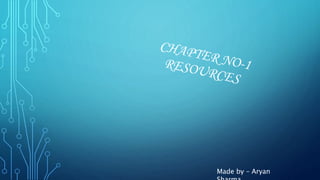Resources
•Als PPTX, PDF herunterladen•
0 gefällt mir•812 views
Melden
Teilen
Melden
Teilen

Empfohlen
Weitere ähnliche Inhalte
Was ist angesagt?
Was ist angesagt? (20)
Ähnlich wie Resources
Resources are defined as matter, space and time utilized for the wellbeing of mankind is called as resources. The natural resources are materials, which living organisms can take from nature for sustaining their life or any components of the natural environment that can be utilized by man to promote his welfare is considered to be natural resources.Environmental Science: Natural resources and their management sudeshrathod

Environmental Science: Natural resources and their management sudeshrathodDr. Sudesh D. Rathod, B N Bandodkar College of Science
Ähnlich wie Resources (20)
Environmental Science: Natural resources and their management sudeshrathod

Environmental Science: Natural resources and their management sudeshrathod
CLASSIFICATION OF RESOURCES CLASS 10TH CBSE/NCERT/JKBOSE

CLASSIFICATION OF RESOURCES CLASS 10TH CBSE/NCERT/JKBOSE
Kürzlich hochgeladen
Making communications land - Are they received and understood as intended? webinar
Thursday 2 May 2024
A joint webinar created by the APM Enabling Change and APM People Interest Networks, this is the third of our three part series on Making Communications Land.
presented by
Ian Cribbes, Director, IMC&T Ltd
@cribbesheet
The link to the write up page and resources of this webinar:
https://www.apm.org.uk/news/making-communications-land-are-they-received-and-understood-as-intended-webinar/
Content description:
How do we ensure that what we have communicated was received and understood as we intended and how do we course correct if it has not.Making communications land - Are they received and understood as intended? we...

Making communications land - Are they received and understood as intended? we...Association for Project Management
Kürzlich hochgeladen (20)
HMCS Max Bernays Pre-Deployment Brief (May 2024).pptx

HMCS Max Bernays Pre-Deployment Brief (May 2024).pptx
Salient Features of India constitution especially power and functions

Salient Features of India constitution especially power and functions
Beyond_Borders_Understanding_Anime_and_Manga_Fandom_A_Comprehensive_Audience_...

Beyond_Borders_Understanding_Anime_and_Manga_Fandom_A_Comprehensive_Audience_...
On National Teacher Day, meet the 2024-25 Kenan Fellows

On National Teacher Day, meet the 2024-25 Kenan Fellows
ICT Role in 21st Century Education & its Challenges.pptx

ICT Role in 21st Century Education & its Challenges.pptx
Making communications land - Are they received and understood as intended? we...

Making communications land - Are they received and understood as intended? we...
Food safety_Challenges food safety laboratories_.pdf

Food safety_Challenges food safety laboratories_.pdf
Basic Civil Engineering first year Notes- Chapter 4 Building.pptx

Basic Civil Engineering first year Notes- Chapter 4 Building.pptx
Interdisciplinary_Insights_Data_Collection_Methods.pptx

Interdisciplinary_Insights_Data_Collection_Methods.pptx
HMCS Vancouver Pre-Deployment Brief - May 2024 (Web Version).pptx

HMCS Vancouver Pre-Deployment Brief - May 2024 (Web Version).pptx
Resources
- 1. Made by – Aryan
- 2. INTRODUCTION Mona and Raju were cleaning their house with their amma. They saw so many things that are used on the every day basis like clothes, utensils, etc. Their amma said that these are called resources. Resources have utility. Utility means usability of any thing. Resources also have value. Value means worth of anything. Some resources can become economically valuably
- 3. TYPES OF RESOURCES There are three types of resources:- 1. Natural Resources 2. Human made resources 3. Human resource
- 4. NATURAL RESOURCES The resources that are drawn from nature and used without much modification are called NATURAL RESOURCES. The air we breath, the water we drink are some of the example of natural resources. Natural resources are classified into different groups depending upon their level of development and use origin; stock and distribution. Resources classified into two groups Actual and Potential resources. Actual resources:- Actual resources are those resources
- 5. Potential resources:- Potential resources are those resources whose entire quantity may not be known and these are not being used at present. Example:- the uranium found in Ladakh, high speed wind are a example of potential resource. Based on their origin the resources are classified as biotic or abiotic. Abiotic resources are non-living resources like coal, petroleum etc. whereas the biotic resources are living like plants etc. Natural resources can be broadly categorized into renewable or non-renewable resources. Renewable resources are those resources which get renewed or replenished quickly. They not get disturbed by the human activity. Some of them are unlimited and can not be finished
- 6. Non- renewable resources are those resources which can not be renewed and have a limited stock. Once a stock is exhausted it takes thousands of years to replenish. On the basis of their distribution resources can be ubiquitous or localized. Resources that are found everywhere like the air we breathe, are ubiquitous. But those which are found only in certain places are localized like copper and iron ore. Distribution of natural resources depends upon factors like terrain; climate and altitude.
- 7. HUMAN MADE RESOURCES Natural substance become resources only when their original form has been changed like we extract iron from the ironore. The iron which is extract from the ironore is human made resources. Technology is also a human made resource.
- 8. HUMAN RESOURCES Human are a important resources because by their education and skills they can create their own Improving the quality of people’s skills so that they are able to create more resources is known as Human resources development.
- 9. CONSERVING RESOURCES Using resources carefully and giving them time to get renewed is called resource conservation. Balancing the need to use resources and also conserve them for future is called sustainable development. Each person can contribute by reducing consumption, recycling and reusing things.